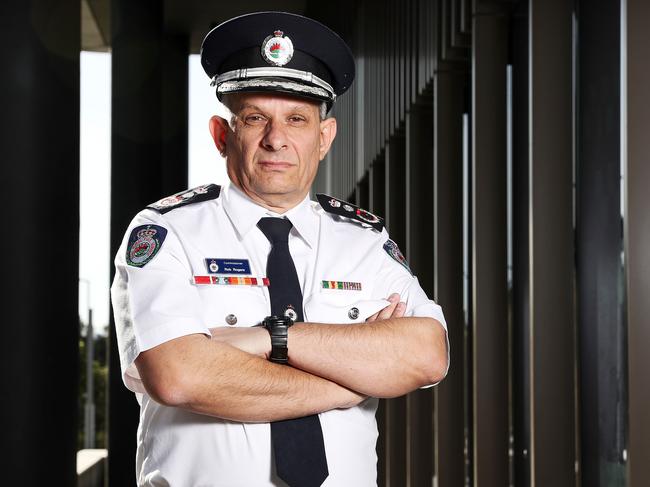Water-bombing fleet, trucks that don’t roll top priorities for RFS
Stepping into the top job at the NSW Rural Fire Service after one of the worst bushfire seasons on record, Rob Rogers has a clear vision of what his top priorities are as he braces for the summer ahead.
NSW
Don't miss out on the headlines from NSW. Followed categories will be added to My News.
Australia’s own water-bombing fleet, fire trucks that don’t roll over and supporting traumatised fireys are top priorities for new Rural Fire Service boss Rob Rogers.
A week into the top role, Mr Rogers, 56, has reflected on the lessons learned in the bushfire season that devastated NSW and claimed 25 lives.
Predicting the next season to begin in August, Mr Rogers, an RFS veteran of 40 years, has outlined his plan to tackle this year’s bushfires — and recover from the last.

That plan includes two new aircraft to map fire grounds and push warnings out earlier, a review of the fire-truck fleet and safety equipment — including face masks and helmets — and helping RFS volunteers impacted by the trauma and loss of last season get back on their feet.
MORE NEWS
Syndicate used Mosman boutique to smuggle $100m of drugs
Bouncing back after baby just don’t call them Super Mums
The availability of firefighting aircraft has been a contentious issue, with Australia
traditionally leasing water-bombing tankers from countries such as Canada to supplement its domestic fleet during the fire season.
The contracted LATs are shared across states, but Mr Rogers said there is an argument for Australia to have its own firefighting aircraft permanently.
“I am very keen to see that happening,” he said.
“That is not just a state conversation but a national conversation that needs to happen.”
Police and Emergency Services Minister David Elliott supported the view, saying he would continue to take advice from experts like Mr Rogers. “Recent history shows fire seasons in the northern and southern hemispheres are converging,” Mr Elliott said.
“With a finite amount of firefighting resources globally, it only makes sense that Australia invests in its own domestic aerial firefighting capability to be used at home and abroad.”

Last year, NSW became the first state in Australia to have its own permanent 737 LAT after the state government spent $26.3million on the RFS Marie Bashir plane.
Mr Rogers said that aircraft helped fight fires across the country last year.
While concise fire modelling isn’t available yet, Mr Rogers said there were still a lot of areas around Sydney — such as Hornsby, the Sutherland Shire and Gosford — that weren’t burned in summer.
Recent rain in country areas would also lead to growth but drought-imposed destocking created the potential for grass fires this coming season.
Mr Rogers’ career in the volunteer brigade has followed a similar trajectory to Shane Fitzsimmons, who has now left the RFSto head the government’s new disaster preparedness and recovery organisation Resilience NSW. He joined the Belrose brigades a volunteer when he was 15, before eventually leaving an uninspiring job at an IT firm to pursue a RFS career.
“Most people in the RFS have come from being volunteers,” he said.

“I think that is good, because those people have an appreciation of what the volunteers are feeling and what motivates them.”
While Mr Rogers has worked through other fire emergencies, such as the 2003 Canberra and 2013 Blue Mountains fires, last summer was like “10 fire seasons rolled into one”.
Mr Rogers, a father-of-two, became a familiar face to the public. He fronted the press almost daily to deliver the latest warnings or detail the fires’ mounting toll with measure and empathy.
He remembers a very telling moment in December when the fires burning around the north and central west had dropped from more than 100 to 50 and it felt like a reprieve, only for a band of dry lightning to ignite the south coast. “I had a bad feeling this is not going to end well,” Mr Rogers recalled.


“The summer’s fires behaved in a way experts had never seen before, the spread defying predictions and decimating towns.
“I think this fire season, all the rules for fire went out the window,” Mr Rogers, appointed for 12 months, said. One of the darkest days was when a water-bombingbombing aircraft with three heroes on board exploded in mid-air.
After the wreckage of the C-130 Large Air Tanker (LAT) was found smouldering on a rural paddock in the Snowy Mountains in January, Mr Rogers had to then tell the family-run North American aviation company, which had been employed to help the RFS, that there were no survivors.
“It is just awful.”

